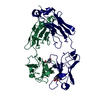[English] 日本語
 Yorodumi
Yorodumi- PDB-2y36: Crystal structure analysis of the anti-(4-hydroxy-3-nitrophenyl)-... -
+ Open data
Open data
- Basic information
Basic information
| Entry | Database: PDB / ID: 2y36 | ||||||
|---|---|---|---|---|---|---|---|
| Title | Crystal structure analysis of the anti-(4-hydroxy-3-nitrophenyl)- acetyl murine germline antibody BBE6.12H3 Fab fragment in complex with a phage display derived dodecapeptide DLWTTAIPTIPS | ||||||
 Components Components |
| ||||||
 Keywords Keywords | IMMUNE SYSTEM / BETA-SANDWICH IMMUNOGLOBULIN FOLD / ANTIGEN BINDING / SECRETED PROTEIN | ||||||
| Function / homology | Immunoglobulins / Immunoglobulin-like / Sandwich / Mainly Beta Function and homology information Function and homology information | ||||||
| Biological species |  SYNTHETIC CONSTRUCT (others) | ||||||
| Method |  X-RAY DIFFRACTION / X-RAY DIFFRACTION /  SYNCHROTRON / SYNCHROTRON /  MOLECULAR REPLACEMENT / Resolution: 2.7 Å MOLECULAR REPLACEMENT / Resolution: 2.7 Å | ||||||
 Authors Authors | Khan, T. / Salunke, D.M. | ||||||
 Citation Citation |  Journal: J.Immunol. / Year: 2012 Journal: J.Immunol. / Year: 2012Title: Structural Elucidation of the Mechanistic Basis of Degeneracy in the Primary Humoral Response. Authors: Khan, T. / Salunke, D.M. | ||||||
| History |
|
- Structure visualization
Structure visualization
| Structure viewer | Molecule:  Molmil Molmil Jmol/JSmol Jmol/JSmol |
|---|
- Downloads & links
Downloads & links
- Download
Download
| PDBx/mmCIF format |  2y36.cif.gz 2y36.cif.gz | 96.8 KB | Display |  PDBx/mmCIF format PDBx/mmCIF format |
|---|---|---|---|---|
| PDB format |  pdb2y36.ent.gz pdb2y36.ent.gz | 73.5 KB | Display |  PDB format PDB format |
| PDBx/mmJSON format |  2y36.json.gz 2y36.json.gz | Tree view |  PDBx/mmJSON format PDBx/mmJSON format | |
| Others |  Other downloads Other downloads |
-Validation report
| Summary document |  2y36_validation.pdf.gz 2y36_validation.pdf.gz | 441.9 KB | Display |  wwPDB validaton report wwPDB validaton report |
|---|---|---|---|---|
| Full document |  2y36_full_validation.pdf.gz 2y36_full_validation.pdf.gz | 462.9 KB | Display | |
| Data in XML |  2y36_validation.xml.gz 2y36_validation.xml.gz | 21 KB | Display | |
| Data in CIF |  2y36_validation.cif.gz 2y36_validation.cif.gz | 28.6 KB | Display | |
| Arichive directory |  https://data.pdbj.org/pub/pdb/validation_reports/y3/2y36 https://data.pdbj.org/pub/pdb/validation_reports/y3/2y36 ftp://data.pdbj.org/pub/pdb/validation_reports/y3/2y36 ftp://data.pdbj.org/pub/pdb/validation_reports/y3/2y36 | HTTPS FTP |
-Related structure data
- Links
Links
- Assembly
Assembly
| Deposited unit | 
| ||||||||
|---|---|---|---|---|---|---|---|---|---|
| 1 |
| ||||||||
| Unit cell |
|
- Components
Components
| #1: Antibody | Mass: 23640.480 Da / Num. of mol.: 1 / Fragment: ANTIGEN-BINDING FRAGMENT, RESIDUE 1-220 / Source method: isolated from a natural source / Source: (natural)  |
|---|---|
| #2: Antibody | Mass: 22538.885 Da / Num. of mol.: 1 / Fragment: ANTIGEN-BINDING FRAGMENT, RESIDUES 1-211 / Source method: isolated from a natural source / Source: (natural)  |
| #3: Protein/peptide | Mass: 1314.483 Da / Num. of mol.: 1 / Source method: obtained synthetically / Source: (synth.) SYNTHETIC CONSTRUCT (others) |
| #4: Water | ChemComp-HOH / |
| Has protein modification | Y |
-Experimental details
-Experiment
| Experiment | Method:  X-RAY DIFFRACTION / Number of used crystals: 1 X-RAY DIFFRACTION / Number of used crystals: 1 |
|---|
- Sample preparation
Sample preparation
| Crystal | Density Matthews: 2.02 Å3/Da / Density % sol: 39.15 % / Description: NONE |
|---|---|
| Crystal grow | pH: 7.1 Details: 0.05M TRIS HCL, 0.025% SODIUM AZIDE, PEG 3350., pH 7.1 |
-Data collection
| Diffraction | Mean temperature: 287 K |
|---|---|
| Diffraction source | Source:  SYNCHROTRON / Site: SYNCHROTRON / Site:  ESRF ESRF  / Beamline: BM14 / Wavelength: 0.9537 / Beamline: BM14 / Wavelength: 0.9537 |
| Detector | Type: MARMOSAIC 225 mm CCD / Detector: CCD / Date: Aug 28, 2009 / Details: BENT COLLIMATING MIRROR AND TOROID |
| Radiation | Monochromator: SI(111) MONOCHROMATOR / Protocol: SINGLE WAVELENGTH / Monochromatic (M) / Laue (L): M / Scattering type: x-ray |
| Radiation wavelength | Wavelength: 0.9537 Å / Relative weight: 1 |
| Reflection | Resolution: 2.7→50 Å / Num. obs: 11098 / % possible obs: 100 % / Observed criterion σ(I): 0 / Redundancy: 5.1 % / Biso Wilson estimate: 28.3 Å2 / Rmerge(I) obs: 0.07 / Net I/σ(I): 11.3 |
| Reflection shell | Resolution: 2.7→8.5 Å / Redundancy: 5.1 % / Rmerge(I) obs: 0.28 / Mean I/σ(I) obs: 4.1 / % possible all: 100 |
- Processing
Processing
| Software |
| ||||||||||||||||||||||||||||||||||||||||||||||||||||||||||||
|---|---|---|---|---|---|---|---|---|---|---|---|---|---|---|---|---|---|---|---|---|---|---|---|---|---|---|---|---|---|---|---|---|---|---|---|---|---|---|---|---|---|---|---|---|---|---|---|---|---|---|---|---|---|---|---|---|---|---|---|---|---|
| Refinement | Method to determine structure:  MOLECULAR REPLACEMENT MOLECULAR REPLACEMENTStarting model: NATIVE FAB Resolution: 2.7→50 Å / Rfactor Rfree error: 0.008 / Data cutoff high absF: 1553445.18 / Data cutoff low absF: 0 / Cross valid method: THROUGHOUT / σ(F): 0 / Stereochemistry target values: MAXIMUM LIKELIHOOD Details: IN CHAIN H, RESIDUES 136-140 COULD NOT BE MODELLED OWING TO MISSING ELECTRON DENSITY. IN CHAIN P, SIDECHAINS OF RESIDUES 9, 11, AND 12 COULD NOT BE MODELLED OWING TO MISSING ELECTRON DENSITY.
| ||||||||||||||||||||||||||||||||||||||||||||||||||||||||||||
| Solvent computation | Solvent model: FLAT / Bsol: 45.0508 Å2 / ksol: 0.4 e/Å3 | ||||||||||||||||||||||||||||||||||||||||||||||||||||||||||||
| Displacement parameters | Biso mean: 42.4 Å2
| ||||||||||||||||||||||||||||||||||||||||||||||||||||||||||||
| Refine analyze |
| ||||||||||||||||||||||||||||||||||||||||||||||||||||||||||||
| Refinement step | Cycle: LAST / Resolution: 2.7→50 Å
| ||||||||||||||||||||||||||||||||||||||||||||||||||||||||||||
| Refine LS restraints |
| ||||||||||||||||||||||||||||||||||||||||||||||||||||||||||||
| LS refinement shell | Resolution: 2.7→2.87 Å / Rfactor Rfree error: 0.026 / Total num. of bins used: 6
| ||||||||||||||||||||||||||||||||||||||||||||||||||||||||||||
| Xplor file |
|
 Movie
Movie Controller
Controller
















 PDBj
PDBj


